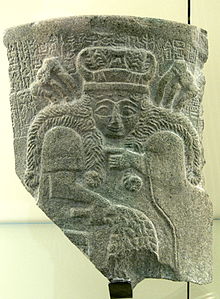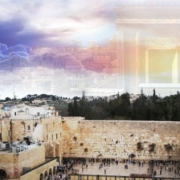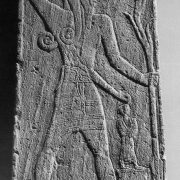Nimrod was born in the second generation after the flood. His father was Cush, son of Ham, son
of Noah. In Sumerian history, the second king of Uruk after the flood was named Enmerkar, son
of Mesh-ki-ang-gasher.
The Hebrews, doing what they loved to do with language, transformed Enmer—the consonants
N-M-R (remember, no vowels in ancient Hebrew)—into Nimrod, which makes it sound like
marad, the Hebrew word for “rebel”.
As we mentioned in an earlier article in this series, an epic poem called Enmerkar and the Lord
of Aratta from around the time of Abraham, circa 2000 B.C., preserves the basic details of the
Tower of Babel story.
We don’t know exactly where Aratta was, but guesses range from northern Iran to Armenia.
(Which would be interesting. Not only is Armenia located near the center of an ancient kingdom
called Urartu, which may be a cognate for Aratta, it’s where Noah landed his boat—the
mountains of Ararat. So Nimrod/Enmerkar may have been intimidating his cousins who settled
close to where their great-grandfather landed the ark.) Wherever it was, Enmerkar muscled this
neighboring kingdom to compel them to send building materials for a couple of projects near and
dear to his heart.
The poem refers to Enmerkar’s capital city, Uruk, as the “great mountain”. This is intriguing,
since Uruk, like most of Sumer, sits in an alluvial plain where there are precisely no mountains
whatsoever. Uruk was home to two of the chief gods of the Sumerian pantheon, Anu, the sky
god, and Inanna, his granddaughter, the goddess of war and sex. And by “sex,” we mean the
carnal, extramarital kind.
While Anu was pretty much retired, having handed over his duties as head of the pantheon to
Enlil, Inanna played a very active role in Sumerian society. For example, scholars have translated
ritual texts for innkeepers to pray to Innana, asking her to guarantee that their bordellos turn a
profit.
Apparently, the conflict between Enmerkar and the king of Aratta, whose name, we learn from a
separate epic, was Ensuhkeshdanna, was a dispute over who was Inanna’s favorite. One of the
building projects Enmerkar wanted to tackle was a magnificent temple to Inanna, the E-ana
(“House of Heaven”). He wanted Aratta to supply the raw materials. Apparently, this wasn’t only
because there isn’t much in the way of timber, jewels, or precious metal in the plains of Sumer,
but because Enmerkar wanted the lord of Aratta to submit and acknowledge that he was Inanna’s
chosen one. And so Enmerkar prayed to Inanna:
“My sister, let Aratta fashion gold and silver skillfully on my behalf for Unug [Uruk].
Let them cut the flawless lapis lazuli from the blocks, let them …… the translucence of
the flawless lapis lazuli ……. …… build a holy mountain in Unug. Let Aratta build a
temple brought down from heaven — your place of worship, the Shrine E-ana; let Aratta
skillfully fashion the interior of the holy jipar, your abode; may I, the radiant youth, may
I be embraced there by you. Let Aratta submit beneath the yoke for Unug on my
behalf.” 1
Notice that Inanna’s temple was, like Uruk, compared to a holy mountain. And given the type of
goddess Inanna was, the embrace Enmerkar wanted was more than just—ahem—a figure of
speech.

The Burney Relief at the British Museum is a terra cotta plaque dated to 1800-1750 B.C. It’s
believed to represent the goddess Inanna, also known as Ishtar, and later as Astarte of the Bible.
To be honest, some of the messages between Enmerkar and Ensuhkeshdanna about Inanna were
the kind of locker room talk that got Donald Trump into trouble during the 2016 presidential
campaign. But I digress.
Well… no. Let’s continue with the digression for a minute. We should stop for a brief look at
Inanna’s role in human history. The goddess has been known by many names through the ages:
Inanna in Sumer, Ishtar in Babylon, Astarte in Canaan, Atargatis in Syria, Aphrodite in Greece,
and Venus across the Roman world. Let’s just say the image we were taught of Aphrodite/Venus
in high school mythology class was way off.
Since we’d like to keep this a family-friendly article, we won’t dig too deeply into the history
and characteristics of Inanna. Scholars don’t completely agree on the details, but it’s safe to say
the goddess wasn’t a girl you’d bring home to meet your mother.
In fact, she wasn’t always a girl, period. You see, while Inanna was definitely the goddess with
the mostest when it came to sex appeal, she was also androgynous. She was sometimes shown
with masculine features like a beard. On one tablet (although from much later, in the first
millennium B.C., almost three thousand years after Nimrod), Inanna says, “When I sit in the
alehouse, I am a woman, and I am an exuberant young man.” 2 Her cult followers included
eunuchs and transvestites, and she was apparently the first in history to make a practice of sex
reassignment:
She [changes] the right side (male) into the left side (female),
She [changes] the left side into the right side,
She [turns] a man into a woman,
She [turns] a woman into a man
She ador[ns] a man as a woman,
She ador[ns] a woman as a man. 3
It’s wonderfully ironic. The 21st century progressive ideal of gender fluidity was personified
more than five thousand years ago by the Sumerian goddess Inanna, a woman who craved sex
and fighting as much (or more) than men, taking on all comers in love and war, and better than
men at both. Her personality is celebrated by modern scholars as complex and courageous,
transcending traditional gender roles, turning Inanna into an icon of independent
man/woman/other-hood.
There is an ongoing debate among scholars as to whether the priesthood of Inanna was involved
in ritual sex. The concept of divine marriage was common in ancient Mesopotamia, but generally
the participants were a god and his consort. It appears that the rituals were intended to please the
god so he’d be receptive to the requests from a city or kingdom under his protection.
However, as a harimtu, which may mean “temple prostitute” or may have simply referred to a
single woman, Inanna herself participated in the rite with a king. And since she was the dominant
partner in the ritual coupling, gender roles might not have been as clearly defined as we would
assume.
From a Christian perspective, however, Inanna isn’t complex at all. She’s a bad Hollywood
screenwriter’s idea of a 15-year-old boy’s fantasy woman. Inanna is selfish, ruled by her
passions, and destructive when she doesn’t get her way. The Sumerian hero Gilgamesh, who
ruled Uruk two generations after Enmerkar, is remembered partly for rejecting Inanna. As he
pointed out in the story, every one of the men in her life suffered horrible consequences—for
example, Dumuzi the Shepherd, who ruled as a king in Bad-Tibara, the second city in Sumer to
exercise kingship after Eridu.
In the myth, even though Inanna married Dumuzi, she was happy to throw him under the bus
when demons tried to drag her younger son, Lulal, down to the netherworld. At Inanna’s urging,
the demons spared Lulal and took Dumuzi instead. Dumuzi’s sister pleaded for him, so Inanna
agreed to allow her to take his place for half the year, thus making Dumuzi the first of many
“dying and rising gods” in the ancient Near East.
More than two thousand years later, one of the abominations God showed the prophet Ezekiel
was women at the entrance of the north gate of the Temple weeping for Dumuzi, called Tammuz
in the Bible.
Well, for his impudence at daring to remind Inanna about the fate of Dumuzi, and the other fools
who’d succumbed to the charms of the wild goddess, she flew up to heaven in a rage and
demanded that her father, the sky god Anu, unleash the Bull of Heaven on Gilgamesh. That
didn’t go well for the Bull of Heaven, but sadly for Gilgamesh, his best friend Enkidu was killed
by the gods as punishment for spoiling Inanna’s revenge.
We share all of this with you to make a point: This is the deity Enmerkar/Nimrod wanted to make
the patron goddess of his city, Uruk. Could it be that veneration of the violent, sex-crazed,
gender-bending Inanna was responsible for Yahweh’s decision to stop Nimrod’s artificial holy
mountain?
Well, no, probably not. Inanna has enjoyed a very long run near the top of the Most Popular
Deities list. And why not? Selling humans on the concept of sex as worship is easy.
Looking at the values of our modern society, it’s no stretch to say that Inanna is the spirit of the
age. Gender fluidity is the flavor of the month among progressives in the West. The values of
Inanna—immediate gratification and sex with whoever, whenever—are considered more open-
minded, tolerant, and loving than the virtues of chastity, fidelity, and faithfulness introduced by
Yahweh long after Inanna was first worshiped as the Queen of Heaven.
Of course, this means the so-called progressive ideas about gender and sexual morality promoted
by academia and the mainstream media are actually REgressive! The enlightened think they’re
on the cutting edge, breaking new ground and smashing old paradigms, when in fact they’re just
setting the calendar back to more than a thousand years before Abraham.
If Yahweh had genuinely intervened to put a stop to the cult of Inanna, she would be long
forgotten. Instead, as the Queen of Heaven. mentioned by the prophet Jeremiah, her cult has
continued for thousands of years. She became Aphrodite and Venus of the classical era, and was
eventually Christianized and venerated as the Virgin Mary.
But the transgression of Nimrod was much more serious than worshiping Inanna. He tried to
expand and upgrade the home of the god Enki, the abzu—the abyss—to create a dwelling place
for the gods on Earth.
For more on that story, see our earlier article, “ The Tower of Babel: Abode of the Gods. ”
1 Black, J.A., Cunningham, G., Fluckiger-Hawker, E, Robson, E., and Zólyomi, G. “Enmerkar
and the Lord of Aratta,” The Electronic Text Corpus of Sumerian Literature
(http://etcsl.orinst.ox.ac.uk/cgi-bin/etcsl.cgi?text=t.1.8.2.3#), retrieved 12/17/16.
2 Black, J.A., Cunningham, G., Fluckiger-Hawker, E, Robson, E., and Zólyomi, G. “A cir-
namcub to Inana (Inana I),” The Electronic Text Corpus of Sumerian Literature
(http://etcsl.orinst.ox.ac.uk/cgi-bin/etcsl.cgi?text=t.4.07.9&charenc=j#), retrieved 12/17/16.
3 Sjoberg, A.W. “In-nin Sa-gur-ra: A Hymn to the Goddess Inanna,” Zeitschrift fur Assyriologie
65, no. 2 (1976), p. 225.

Derek Gilbert Bio
Derek P. Gilbert hosts SkyWatchTV, a Christian television program that airs on several national networks, the long-running interview podcast A View from the Bunker, and co-hosts SciFriday, a weekly television program that analyzes science news with his wife, author Sharon K. Gilbert.
Before joining SkyWatchTV in 2015, his secular broadcasting career spanned more than 25 years with stops at radio stations in Philadelphia, Saint Louis, Little Rock, and suburban Chicago.
Derek is a Christian, a husband and a father. He’s been a regular speaker at Bible prophecy conferences in recent years. Derek’s most recent book is The Great Inception: Satan’s PSYOPs from Eden to Armageddon. He has also published the novels The God Conspiracy and Iron Dragons, and he’s a contributing author to the nonfiction anthologies God’s Ghostbusters, Blood on the Altar, I Predict: What 12 Global Experts Believe You Will See by 2025, and When Once We Were a Nation.













Leave a Reply
Want to join the discussion?Feel free to contribute!